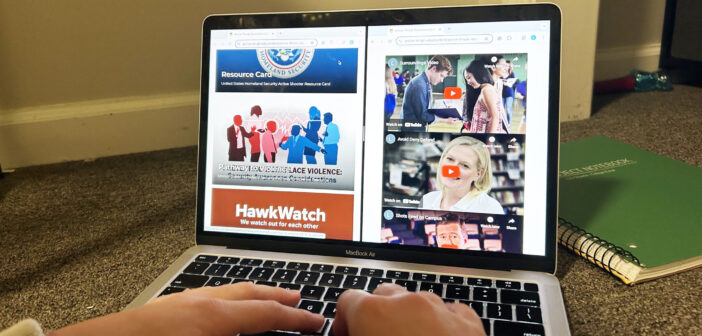The Lehigh University Police Department recently introduced a three-part series of active threat training sessions that will occur throughout this semester.
Sergeant Kyle Fisher, who is a part of the department’s investigative and professional services division, taught the first session of the series, an hour-long active threat training session for students and faculty, on Sept. 19.
The event also functioned as a 5×10 session and included a presentation with informational videos and demonstrations about what to do in the case of an active threat. The department then introduced new changes they’ve made.
“It is information that is not only applicable here at Lehigh but also when you’re at the supermarket or when you’re out to dinner at a restaurant or back home if you go back to high school for a basketball game,” Fisher said. “This is information that everybody should know.”
LUPD partnered with the ALERRT center in September 2023 to enhance their training and create an even safer campus for Lehigh members, Fisher said. The ALERRT Center, created at Texas State University in 2022, is an organization that addresses the need for active shooter response training for first responders.
Fisher said the first step LUPD took was certifying all of its police officers as civilian response instructors because previously only one of their officers was trained in active threat situations.
He also said the training ensures all officers can answer any questions community members may have.
The next step LUPD took was altering the training material they send to the university related to active threat situations.
“It was antiquated,” Fisher said. “It was outdated, and I don’t think that it gave enough useful information.”
Fisher said updating the active threat protocol language included changing the term “active shooter” to “active threat,” as this prepares people to respond to any threat — not just a firearm.
The department also adapted their crisis response phrase from “Run/Hide/Fight” to “Avoid/Deny/Defend,” and Fisher said this was done to be more inclusive and empowering.
“When the first action word is something that not everybody can do, those people might not feel welcome at that training,” Fisher said. “They may feel powerless.”
The word “hide” might make people feel helpless, he said. A stronger action word like “deny” suggests either hiding or securing yourself inside a room.
During the training session, Fisher discussed how people typically tend to respond versus how people should react.
He said he recommends always having a “script” or a mental play-by-play of what to do in the case of an emergency.
For example, in a classroom, one can think of how to lock or blockade the door, look for alternate exits, or look for items like a metal water bottle that could be used for defense.
Mika Peleg, ‘28, attended the session and watched an officer demonstrate how to use the newly installed Nightlock security devices, what objects to block the door with and potential objects to use as a defense.
“If this does happen, I now know to stay calm to take action,” Peleg said. “Panicking is not going to get you anywhere.”
One of the videos shown at the session, courtesy of the Sandy Hook Promise organization, followed a boy’s normal school experience while showing someone else planning a shooting in the background. The video explained how gun violence is preventable when you know the signs.
Kaylin Velasquez, ‘28, also attended the session and said the ending of the video caught her off guard, as she wasn’t paying attention to the warning signs while watching.
“I learned you have to make sure that you calm yourself down,” Velasquez said. “Make sure that you are ready to do whatever you have to do, and you can’t be scared. You have to be ready.”
Peleg said this 5×10 is an important one to attend because she learned a lot, and it was very informative.
Fisher said LUPD has updated their website to include videos on how to use the Nightlock devices, how to respond to active threat situations and how to recognize suspicious behavior.
“We are always seeking ways to better keep our campus safe, and we thought that this updated information and training was long overdue,” Fisher said.
Members of the Lehigh community can also use the Hawk Watch app for emergency numbers and safety resources.
The remaining active threat training sessions will take place on Sept. 27 from 12 to 1 p.m., and Oct. 8 from 4 to 5 p.m.
“It’s our hope that people take it seriously and that they attend these training sessions and encourage their friends to attend,” Fisher said. “It’s also our hope that they give us feedback on how we can continuously make our campus a safer place.”






Comment policy
Comments posted to The Brown and White website are reviewed by a moderator before being approved. Incendiary speech or harassing language, including comments targeted at individuals, may be deemed unacceptable and not published. Spam and other soliciting will also be declined.
The Brown and White also reserves the right to not publish entirely anonymous comments.